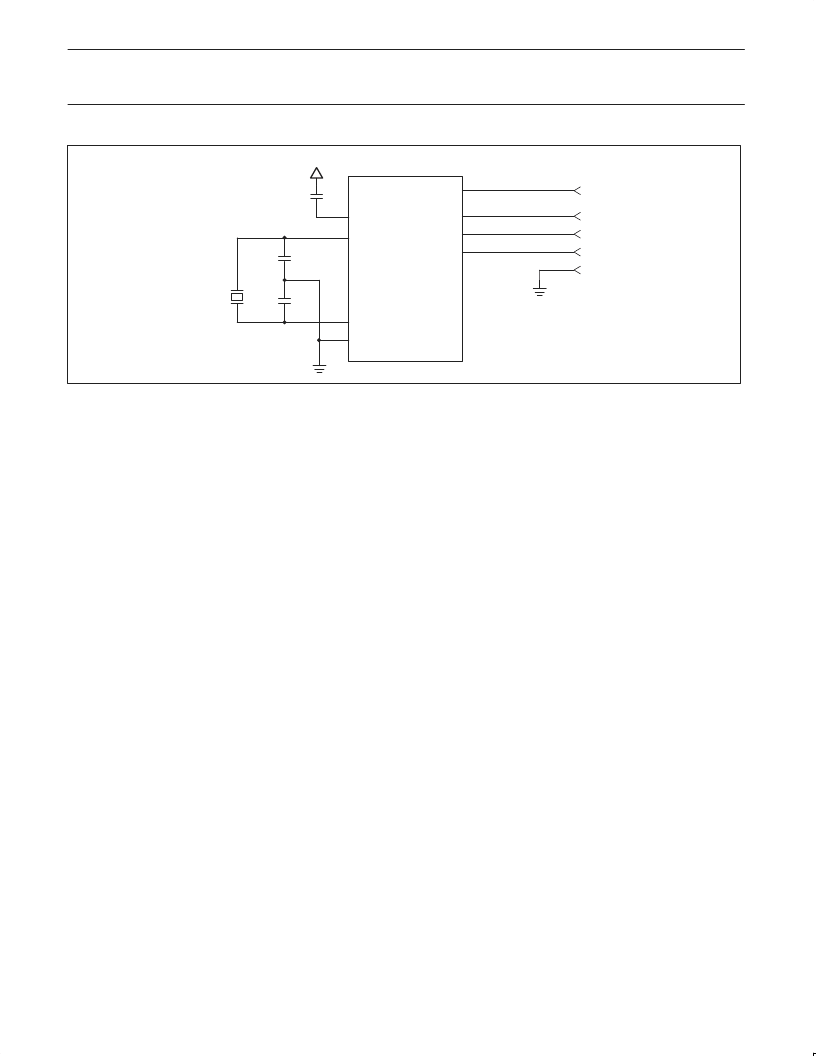- 您现在的位置:买卖IC网 > PDF目录367741 > P89C61X2 (NXP Semiconductors N.V.) 80C51 8-bit Flash microcontroller family PDF资料下载
参数资料
| 型号: | P89C61X2 |
| 厂商: | NXP Semiconductors N.V. |
| 元件分类: | 8位微控制器 |
| 英文描述: | 80C51 8-bit Flash microcontroller family |
| 中文描述: | 80C51的8位闪存微控制器系列 |
| 文件页数: | 14/56页 |
| 文件大小: | 342K |
| 代理商: | P89C61X2 |
第1页第2页第3页第4页第5页第6页第7页第8页第9页第10页第11页第12页第13页当前第14页第15页第16页第17页第18页第19页第20页第21页第22页第23页第24页第25页第26页第27页第28页第29页第30页第31页第32页第33页第34页第35页第36页第37页第38页第39页第40页第41页第42页第43页第44页第45页第46页第47页第48页第49页第50页第51页第52页第53页第54页第55页第56页

Philips Semiconductors
Product data
P89C60X2/61X2
80C51 8-bit Flash microcontroller family
64KB Flash, 512B/1024B RAM
2003 Sep 11
14
+5 V (+12 V tolerant)
+5 V
TxD
RxD
V
SS
V
PP
V
CC
TxD
RxD
RST
XTAL2
XTAL1
SU01674
V
SS
V
CC
P89C60X2
P89C61X2
Figure 2. In-System Programming with a Minimum of Pins
In-System Programming (ISP)
The In-System Programming (ISP) is performed without removing
the microcontroller from the system. The In-System Programming
(ISP) facility consists of a series of internal hardware resources
coupled with internal firmware to facilitate remote programming of
the P89C60X2/61X2 through the serial port. This firmware is
provided by Philips and embedded within each P89C60X2/61X2
device.
The Philips In-System Programming (ISP) facility has made in-circuit
programming in an embedded application possible with a minimum
of additional expense in components and circuit board area.
The ISP function uses five pins: TxD, RxD, V
SS
, V
CC
, and V
PP
(see
Figure 2). Only a small connector needs to be available to interface
your application to an external circuit in order to use this feature.
The V
PP
supply should be adequately decoupled and V
PP
not
allowed to exceed datasheet limits.
Free ISP software is available from the Embedded Systems
Academy: “FlashMagic”
1. Direct your browser to the following page:
http://www.esacademy.com/software/flashmagic/
2. Download Flashmagic
3. Execute “flashmagic.exe” to install the software
Using the In-System Programming (ISP)
The ISP feature allows for a wide range of baud rates to be used in
your application, independent of the oscillator frequency. It is also
adaptable to a wide range of oscillator frequencies. This is
accomplished by measuring the bit-time of a single bit in a received
character. This information is then used to program the baud rate in
terms of timer counts based on the oscillator frequency. The ISP
feature requires that an initial character (an uppercase U) be sent to
the P89C60X2/61X2 to establish the baud rate. The ISP firmware
provides auto-echo of received characters.
Once baud rate initialization has been performed, the ISP firmware
will only accept Intel Hex-type records. Intel Hex records consist of
ASCII characters used to represent hexadecimal values and are
summarized below:
:NNAAAARRDD..DDCC<crlf>
In the Intel Hex record, the “NN” represents the number of data
bytes in the record. The P89C60X2/61X2 will accept up to 16 (10H)
data bytes. The “AAAA” string represents the address of the first
byte in the record. If there are zero bytes in the record, this field is
often set to 0000. The “RR” string indicates the record type. A
record type of “00” is a data record. A record type of “01” indicates
the end-of-file mark. In this application, additional record types will
be added to indicate either commands or data for the ISP facility.
The maximum number of data bytes in a record is limited to 16
(decimal). ISP commands are summarized in Table 2.
As a record is received by the P89C60X2/61X2, the information in
the record is stored internally and a checksum calculation is
performed. The operation indicated by the record type is not
performed until the entire record has been received. Should an error
occur in the checksum, the P89C60X2/61X2 will send an “X” out the
serial port indicating a checksum error. If the checksum calculation
is found to match the checksum in the record, then the command
will be executed. In most cases, successful reception of the record
will be indicated by transmitting a “.” character out the serial port
(displaying the contents of the internal program memory is an
exception).
In the case of a Data Record (record type 00), an additional check is
made. A “.” character will NOT be sent unless the record checksum
matched the calculated checksum and all of the bytes in the record
were successfully programmed. For a data record, an “X” indicates
that the checksum failed to match, and an “R” character indicates
that one of the bytes did not properly program. It is necessary to
send a type 02 record (specify oscillator frequency) to the
P89C60X2/61X2 before programming data.
The ISP facility was designed to that specific crystal frequencies
were not required in order to generate baud rates or time the
programming pulses. The user thus needs to provide the
P89C60X2/61X2 with information required to generate the proper
timing. Record type 02 is provided for this purpose.
相关PDF资料 |
PDF描述 |
|---|---|
| P89C60X2 | 80C51 8-bit Flash microcontroller family |
| P89C660HBBD | 80C51 8-bit Flash microcontroller family |
| P89C660 | 80C51 8-bit Flash microcontroller family |
| P89C660HBA | 80C51 8-bit Flash microcontroller family |
| P89C660HFA | 80C51 8-bit Flash microcontroller family |
相关代理商/技术参数 |
参数描述 |
|---|---|
| P89C61X2BA/00 | 制造商:PHILIPS 制造商全称:NXP Semiconductors 功能描述:80C51 8-bit Flash microcontroller family |
| P89C61X2BA/00,512 | 功能描述:IC 80C51 MCU 512 RAM 44PLCC RoHS:是 类别:集成电路 (IC) >> 嵌入式 - 微控制器, 系列:89C 标准包装:250 系列:56F8xxx 核心处理器:56800E 芯体尺寸:16-位 速度:60MHz 连通性:CAN,SCI,SPI 外围设备:POR,PWM,温度传感器,WDT 输入/输出数:21 程序存储器容量:40KB(20K x 16) 程序存储器类型:闪存 EEPROM 大小:- RAM 容量:6K x 16 电压 - 电源 (Vcc/Vdd):2.25 V ~ 3.6 V 数据转换器:A/D 6x12b 振荡器型:内部 工作温度:-40°C ~ 125°C 封装/外壳:48-LQFP 包装:托盘 配用:MC56F8323EVME-ND - BOARD EVALUATION MC56F8323 |
| P89C61X2BBD/00 | 制造商:PHILIPS 制造商全称:NXP Semiconductors 功能描述:80C51 8-bit Flash microcontroller family |
| P89C61X2BBD/00,557 | 功能描述:IC 80C51 MCU 512 RAM 44LQFP RoHS:是 类别:集成电路 (IC) >> 嵌入式 - 微控制器, 系列:89C 标准包装:250 系列:56F8xxx 核心处理器:56800E 芯体尺寸:16-位 速度:60MHz 连通性:CAN,SCI,SPI 外围设备:POR,PWM,温度传感器,WDT 输入/输出数:21 程序存储器容量:40KB(20K x 16) 程序存储器类型:闪存 EEPROM 大小:- RAM 容量:6K x 16 电压 - 电源 (Vcc/Vdd):2.25 V ~ 3.6 V 数据转换器:A/D 6x12b 振荡器型:内部 工作温度:-40°C ~ 125°C 封装/外壳:48-LQFP 包装:托盘 配用:MC56F8323EVME-ND - BOARD EVALUATION MC56F8323 |
| P89C61X2BN/00 | 制造商:PHILIPS 制造商全称:NXP Semiconductors 功能描述:80C51 8-bit Flash microcontroller family |
发布紧急采购,3分钟左右您将得到回复。